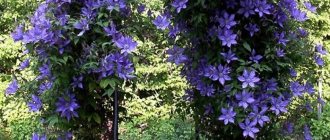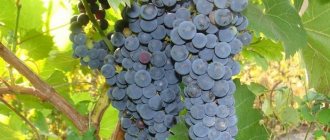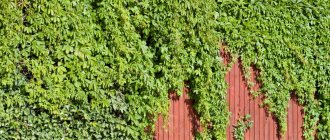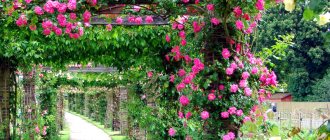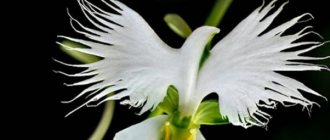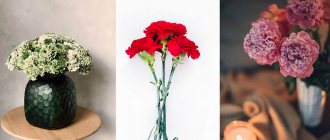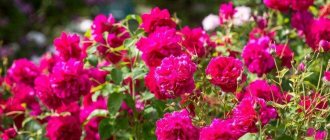Perennial
Before considering each type of climbing plant separately, you should understand the selection parameters.
To make a hedge pleasing to the eye, select young plants taking into account climate, humidity, light, soil composition - these are the most important parameters that guarantee you the most optimal selection. An important nuance is the fence itself. Thin and flimsy will not withstand heavy large vines. Self-clinging plants will not be able to climb on brick; you will have to make garters.
Advice! Do not plant several different species close to each other. You should especially be wary of ivy and hops - they will simply outlive decorative and more demanding neighbors.
Ivy
This climbing plant does not care where it grows, so it is often used in landscape design. Garden ivy survives in both hot sun and cool shade. At the same time, it grows and becomes a beautiful hedge in just a couple of months.
The plant is perennial, you will only have to tinker in the first year - the older the ivy gets, the less attention it requires. From the second year, the gardener's main task will be regular watering and pruning 2-3 times per season.
The photo shows an example of ivy growth
Hop
An excellent choice for those who do not like to care for plants, but want to decorate the garden with climbing plants for the fence. Large juicy leaves, fast growth, beautiful entwining of the fence - with hops this is guaranteed. In July-August the plant blooms profusely, and fragrant light cones are formed in place of the peduncle.
Important! Please note that getting rid of these two plants (hops, ivy) is incredibly difficult: digging or pulling them out is not enough; most likely, new shoots will appear from the ground for several more years.
Clematis
Advice from professionals
In order for perennial vines to please the eye with flowering and beautiful greenery, it is important to listen to the advice of experts. Basic Rules:
- Often perennials prefer to grow in slightly acidic soil, in a sunny place protected from drafts.
- The plant must be suitable for climatic conditions.
- The loach is planted from a wall or fence, retreating at least half a meter.
- The support is installed during planting. It must be strong to withstand the plant during strong winds or snowfall.
- From the first day of planting, you need to form loaches. Otherwise, they will grow and lose their decorative appearance.
- To prolong flowering, it is important to promptly remove faded inflorescences.
Annuals
Not all climbing plants tolerate frost successfully. If you live in a harsh climate, choose fast-growing annuals for the role of climbing plants for the fence.
Sweet pea
It will help to refine the fence and decorate decorative partitions, but it should be taken into account that it reaches only 2-3 meters in height. Grows in any conditions except wetlands. After planting, the plant requires regular standardized watering, high-quality fertilizing and special supports - otherwise it will simply crawl along the ground, occupying the area horizontally.
There are a large number of varieties of sweet peas - they differ mainly in the color and aroma of the buds.
The photo shows weaving climbing peas with shoots
Decorative beans
A light- and heat-loving climbing plant for a fence. Beans are distinguished by their decorative juicy greenery, which is why gardeners love them. It does not require special care, but for more lush growth and abundant landscaping, nitrogen fertilizers can be used.
Also take into account her love for watering: the hotter it is outside, the more often the hedge is watered, up to a daily repetition.
Advice! The fruits of decorative beans can be collected and even eaten - to make more of them, the shoots are regularly pinched.
morning glory
Clematis
Clematis (or clematis) are one of the most common ornamental climbing shrubs. Many types of clematis are able to winter even at temperatures below –25°C, which is why they are ideally suited for growing in the middle zone.
These vines are not only beautiful, but also very fragrant. The flowers bloom on them in all possible shades: from snow-white to rich purple and blue. Moreover, one flower “lives” for several weeks. If you choose the right varieties of clematis that bloom at different times, this climbing plant will continuously decorate your garden from late spring to early autumn.
| Vine length (m) | Flowering time | Soil type | Peculiarities |
| 1-1,2 | May-September (depending on the type and variety) | Sandy, sandy loam, loamy, limestone | The timing of pruning varies depending on the time of flowering and on which shoots the flowers form. |
Winter-hardy
The evergreen climbing perennials from the first section survive even harsh winters without loss, but there are other options.
Honeysuckle
Ornamental species, such as honeysuckle, climb beautifully and bloom profusely throughout the season. But they have a drawback: the berries of these varieties (unlike shrubs) cannot be eaten, they are poisonous - so you should not plant them in an area where children can reach the fruits. Mature plants tolerate frosts without problems; they are not even removed from their supports. Young ones (up to 2-3 years) are best removed and covered at the end of the season.
Honeysuckle loves moist soil, so it is better to mulch the surface after planting to retain moisture. It grows best in the sun; the darker it is, the slower it will develop and bloom less.
Woodplier
As the name implies, this vine has more than enough strength and desire to live: without control, it will quickly kill other plants from the area and take over the territory. But with timely pruning, a hedge, even based on a picket fence or chain-link mesh, looks very decorative.
The tree plier survives the winter without much loss; you should not worry even if some of the shoots freeze. Thanks to its powerful root system, it will quickly recover with the arrival of warmer weather.
In the photo there is a wood plier entwined around an arch
Chinese lemongrass
This type of hedge has nothing to do with citrus fruits; the name was given solely because of the pleasant aroma of the fruit. Schisandra takes root and winters even in Siberian and Far Eastern territories, not to mention the mild winters of the central part of Russia. The only thing to keep in mind is that it does not like the sun, but it is ideal for decorating the shaded side of the fence.
Important! Schisandra stems are dried and brewed as tea - this drink has a restorative, energetic effect. Increases blood pressure, can even replace coffee.
Classification of climbing perennials
Perennial vines are divided into several categories. The differences lie in the life cycle, growth principle, stem structure and method of attachment to the support.
Perennial vines can be:
- Creeping. Vertical growth is possible only with additional support; without it, the plant forms a creeping carpet.
- Climbing. The liana clings to the rough surface with the help of sucker roots.
- Catchy. Thanks to the stem shoots (tendrils), the plant rises along a vertical support.
- Tree-like. In spring, the liana continues its growth from the point to which it stretched during the warm season.
- Herbaceous. The loach dies off by winter, and in the spring new young shoots appear from the root system.
Also, perennial vines can be:
- photophilous;
- shade-tolerant;
- preferring the roots to be located in the shade and the green mass to be in the sun.
Plants with flowers
climbing rose
Suitable for experienced gardeners and those who are ready to care for this complex plant. Thorny shoots with flowers require careful handling and timely garter. But if everything is done correctly, during the flowering period the site will turn into a real imperial garden. It can overwinter, but in the fall it is wrapped and covered. Although even such a scenario does not guarantee a successful winter for the climbing rose.
The photo shows a profusely blooming rose
Important! Climbing roses are more susceptible to attack by aphids and spider mites than others. Carefully monitor the health of the seedling; timely measures taken when pests are detected will save the life of the plant.
Kobeya
In fact, the plant itself is a perennial and in the southern regions it blooms successfully for several years after planting. But it cannot be classified as winter-hardy, so in most of Russia it is grown as an annual - it grows quickly, blooms in the first year, and is suitable for decoration.
The leaves are quite large and beautiful, but kobeya is loved not for them, but for its charming bell-shaped flowers. There is no need for tying; the vine releases tendrils and grabs the support with them, climbing up on its own. Loves sunlight, can grow in partial shade, but not in dark areas.
The photo shows an example of a kobei garter
Nasturtium
Let the sun into your summer cottage: plant the original nasturtium! Near the fence you will need additional lashes and garters along which the plant can climb up. To ensure juicy and long-lasting flowering, plant in a bright place - both open ground and tubs or boxes are suitable. The flowers are large, bright - orange, yellow, red. White or pastel shades are less common.
Wisteria
A beautiful design option for fences, arches, and gazebos. Large clusters of flowers in a fresh purple hue combined with green foliage give a charming look to even the simplest buildings. Wild varieties prefer the hot climate of the subtropics, but breeders have developed species that can survive cold temperatures down to -37C. Are you planning to grow wisteria on your property? Look for the varieties that are most suitable for your climate.
Blooming vines in the garden photos and examples of use in the landscape
A house covered with climbing roses
Entrance arch entwined with climbing roses
House in flowers
Entrance arch decorated with clematis
Morning glory weaving around the house
A gazebo entwined with flowering vines
China latifolia
Latifolia is a member of the Legume family. It is sometimes confused with sweet pea, although it itself does not boast a strong aroma. However, chin is also called broadleaf pea.
This herbaceous plant can reach 4 m in length, clinging to the surface with tendrils. Chyna reproduces well by seeds, withstands frosts down to –29°C, and loves good lighting. The color scheme of large, showy chin flowers is white, pink, red-violet.
| Vine length (m) | Flowering time | Soil type | Peculiarities |
| 1,8-4 | June August | Sandy, sandy loam, loamy, limestone | Reacts poorly to transplantation in adulthood, best propagated by seeds |
